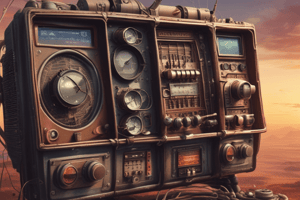Podcast
Questions and Answers
What is the primary function of a DC power supply?
What is the primary function of a DC power supply?
- To amplify the input voltage of a radio receiver
- To convert AC power to DC power (correct)
- To regulate the output voltage of a radio transmitter
- To convert DC power to AC power
What is the unit of measurement for the current draw of a radio device?
What is the unit of measurement for the current draw of a radio device?
- Hertz (Hz)
- Volts (V)
- Watts (W)
- Amperes (A) (correct)
What is the purpose of a voltage regulator in a radio equipment power system?
What is the purpose of a voltage regulator in a radio equipment power system?
- To decrease the input voltage to the device
- To switch between different power sources
- To maintain a stable output voltage despite input variations (correct)
- To increase the input voltage to the device
What type of power supply is known for being efficient, compact, and reliable?
What type of power supply is known for being efficient, compact, and reliable?
What is the primary function of a power distribution unit (PDU)?
What is the primary function of a power distribution unit (PDU)?
What is the primary purpose of a fuse or circuit breaker in a radio equipment power system?
What is the primary purpose of a fuse or circuit breaker in a radio equipment power system?
Flashcards are hidden until you start studying
Study Notes
Radio Equipment Basics
- Radio equipment includes transmitters, receivers, transceivers, and accessories like antennas, cables, and switches
- Radio equipment operates on a range of frequencies, including VHF (30-300 MHz), UHF (300-3000 MHz), and HF (3-30 MHz)
DC Power Basics
- DC (Direct Current) power is used to operate radio equipment
- DC power is provided by a power source, such as a battery or power supply
- DC power is measured in volts (V) and amperes (A)
Radio Equipment Power Requirements
- Radio equipment has specific power requirements, including:
- Operating voltage (e.g., 12V, 24V)
- Current draw (e.g., 1A, 5A)
- Power consumption (e.g., 12W, 50W)
- Exceeding power requirements can damage equipment, while insufficient power can reduce performance
DC Power Supplies
- DC power supplies convert AC (Alternating Current) power from a wall outlet to DC power for radio equipment
- Types of DC power supplies include:
- Linear power supplies: simple, low-cost, but inefficient
- Switch-mode power supplies: efficient, compact, and reliable
- Battery eliminators: convert AC power to DC power, mimicking a battery
Power Distribution and Protection
- Power distribution units (PDUs) manage power to multiple devices
- Fuses and circuit breakers protect against power surges and overcurrent
- Voltage regulators maintain a stable output voltage, despite input variations
Radio Equipment Basics
- Radio equipment consists of transmitters, receivers, transceivers, and accessories like antennas, cables, and switches
- Radio equipment operates on a range of frequencies, including VHF (30-300 MHz), UHF (300-3000 MHz), and HF (3-30 MHz)
DC Power Basics
- DC power is required to operate radio equipment
- Power sources for DC power include batteries and power supplies
- DC power is measured in volts (V) and amperes (A)
Radio Equipment Power Requirements
- Radio equipment has specific power requirements, including an operating voltage (e.g., 12V, 24V)
- Radio equipment has a specific current draw (e.g., 1A, 5A)
- Radio equipment has a specific power consumption (e.g., 12W, 50W)
- Exceeding power requirements can damage the equipment
- Insufficient power can reduce equipment performance
DC Power Supplies
- DC power supplies convert AC power from a wall outlet to DC power for radio equipment
- Linear power supplies are simple, low-cost, but inefficient
- Switch-mode power supplies are efficient, compact, and reliable
- Battery eliminators convert AC power to DC power, mimicking a battery
Power Distribution and Protection
- Power distribution units (PDUs) manage power to multiple devices
- Fuses and circuit breakers protect against power surges and overcurrent
- Voltage regulators maintain a stable output voltage despite input variations
Studying That Suits You
Use AI to generate personalized quizzes and flashcards to suit your learning preferences.



